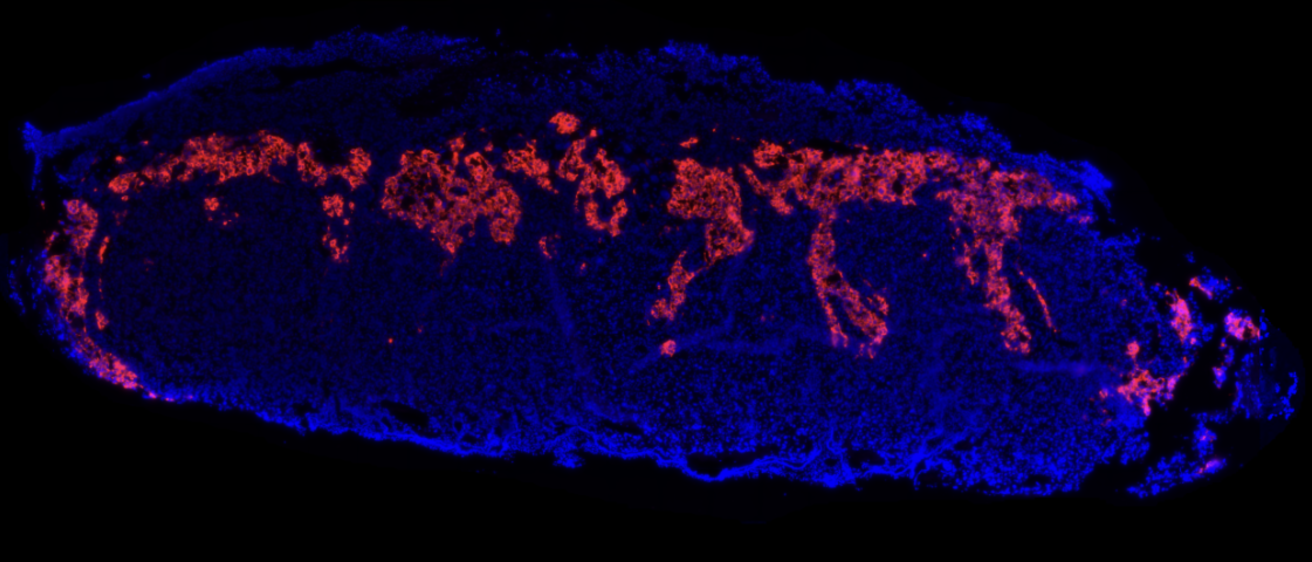
Breadcrumb
- Home
- Publications
Publications
For a list of all publications, see PubMed link below:

Selected Publications:
Carver AJ, Fairbairn FM, Taylor RJ, Boggarapu S, Kamau NR, Gajmer A, Stevens HE. Placental Igf1 overexpression sex-specifically impacts mouse placenta structure, altering offspring striatal development and behavior. Exp Neurol. 2025 Sep 2:115453. doi: 10.1016/j.expneurol.2025.115453.
Carver, A.J., Dunnwald, M., Stevens, H.E. (2025). A head start: The relationship of placental factors to craniofacial and brain development. Developmental Dynamics. doi: 10.1002/dvdy.70018
Maurer, S.V., Hing, B.W.Q., Lussier, S., Radhakrishna, S., Davis, J.L.B., Abbott, P.W., Michaelson, J.J., Stevens, H.E. (2025). Prenatal stress alters mouse offspring dorsal striatum development and placental function in sex-specific ways. J Psychiatr Res. doi: 10.1016/j.jpsychires.2024.12.048.
Menezes, E., de Abreu, F.F., Davis, J.B., Maurer, S.V., Roshko, V.C., Richardson, A., Dowell, J., Cassella, S.N., & Stevens, H.E. (2024). Effects of Gestastional Hypothyroidism on Mouse Brain Development: GABAergic Systems and Oxidative Stress. Developmental Biology, In Press, Journal Pre-proof. doi: 10.1016/j.ydbio.2024.07.010
Carver, A.J., Hing, B., Elser, B.A., Lussier, S.J., Yamanashi, T., Howard, M.A.3rd., Kawasaki, H., Shinozaki, G., & Stevens, H.E. (2024). Correlation of telomere length in brain tissue with peripheral tissues in living human subjects. Front Mol Neurosci., 17:1303974. doi: 10.3389/fnmol.2024.1303974
Evans, M.M., Kim, J., Abel, T., Nickl-Jockschat, T., & Stevens H.E. (2023). Developmental disruptions of the dorsal striatum in autism spectrum disorder. Biol Psychiatry, 95:102-111. doi:10.1016/j.biopsych.2023.08.015
Carver A.J., Taylor R.J., & Stevens H.E. (2023). Mouse In Vivo Placental Targeted CRISPR Manipulation. J Vis Exp., (194):10.3791/64760. doi:10.3791/64760
Stevens, H.E., Scuderi, S., Collica, S.C., Tomasi, S., Horvath, T.L., & Vaccarino, F.M. (2023). Neonatal loss of FGFR2 in astroglial cells affects locomotion, sociability, working memory, and glia-neuron interactions in mice. Transl Psychiatry,13(1):89. doi:10.1038/s41398-023-02372-y
Elser, B.A., Hing, B., & Stevens, H.E. (2022). A narrative review of converging evidence addressing developmental toxicity of pyrethroid insecticides. Crit Rev Toxicol, 52(5):371-388. doi:10.1080/10408444.2022.2122769
Elser, B.A., Simonsen, D., Lehmler, H.J., & Stevens, H.E. (2022). Maternal and fetal tissue distribution of α-cypermethrin and permethrin in pregnant CD-1 mice. Environ Adv., 8:100239. doi:10.1016/j.envadv.2022.100239
Gumusoglu, S.B., Maurer, S.V., & Stevens, H.E. (2022). Dataset describing maternal prenatal restraint stress effects on immune factors in mice. Data Brief, 43:108348. doi:10.1016/j.dib.2022.108348
Davis, J.L., O'Connor, M., Erlbacher, H., Schlichte, S.L., & Stevens, H.E. (2022). The Impact of Maternal Antioxidants on Prenatal Stress Effects on Offspring Neurobiology and Behavior. Yale J Biol Med, 95(1):87-104. PMCID: PMC8961714
Schroeder, R., Nguyen, L., Pieper, A.A., & Stevens, H.E. (2022). Maternal treatment with P7C3-A20 protects from impaired maternal care after chronic gestational stress. Behav Brain Res, 416:113558. doi:10.1016/j.bbr.2021.113558
Stevens, H.E. (2021). Editorial: Macaque At-Birth Adoption: Its Power and Promise. J Am Acad Child Adolesc Psychiatry, 60(11):1345-1347. doi:10.1016/j.jaac.2021.06.002
Gumusoglu, S.B., Chilukuri, A.S.S., Hing, B.W.Q., Scroggins, S.M., Kundu, S., Sandgren, J.A., ...& Stevens, H.E. (2021). Altered offspring neurodevelopment in an arginine vasopressin preeclampsia model. Transl Psychiatry, 11(1), 79. doi:10.1038/s41398-021-01205-0
Kundu, S., Maurer, S.V., & Stevens, H.E. (2021). Future Horizons for Neurodevelopmental Disorders: Placental Mechanisms. Front Pediatr, 9:653230. doi:10.3389/fped.2021.653230
Schroeder, R., Sridharan, P., Nguyen, L., Loren, A., Williams, N.S., Kettimuthu, K.P., ...& Stevens, H.E. (2021). Maternal P7C3-A20 Treatment Protects Offspring from Neuropsychiatric Sequelae of Prenatal Stress. Antioxid Redox Signal, 35(7):511-530. doi:10.1089/ars.2020.8227
Elser, B.A., Kayali, K., Dhakal, R., O'Hare, B., Wang, K., Lehmler, H.J., & Stevens, H.E. (2020). Combined maternal exposure to cypermethrin and stress affect embryonic brain and placental outcomes in mice. Toxicol Sci., 175(2):182-196 doi:10.1093/toxsci/kfaa040
Gumusoglu, S.B., Chilukuri, A.S.S., Santillan, D.A., Santillan, M.K., & Stevens, H.E. (2020). Neurodevelopmental Outcomes of Prenatal Preeclampsia Exposure. Trends Neurosci, 43(4), 253-268. doi:10.1016/j.tins.2020.02.003
Gumusoglu, S.B., Hing, B.W.Q., Chilukuri, A.S.S., Dewitt, J.J., Scroggins, S.M., & Stevens, H. E. (2020). Chronic maternal interleukin-17 and autism-related cortical gene expression, neurobiology, and behavior. Neuropsychopharmacology, 45(6):1008-1017. doi:10.1038/s41386-020-0640-0
Bittle, J., Menezes, E.C., McCormick, M.L., Spitz, D.R., Dailey, M., & Stevens, H.E. (2019). The Role of Redox Dysregulation in the Effects of Prenatal Stress on Embryonic Interneuron Migration. Cereb Cortex, 29(12):5116-5130. doi:10.1093/cercor/bhz052
Dowell, J., Elser, B.A., Schroeder, R.E., & Stevens, H.E. (2019). Cellular stress mechanisms of prenatal maternal stress: Heat shock factors and oxidative stress. Neurosci Lett, 709, 134368. doi:10.1016/j.neulet.2019.134368
Ear, P.H., Chadda, A., Gumusoglu, S.B., Schmidt, M.S., Vogeler, S., Malicoat, J., ...Stevens, H.E. & Brenner, C. (2019). Maternal Nicotinamide Riboside Enhances Postpartum Weight Loss, Juvenile Offspring Development, and Neurogenesis of Adult Offspring. Cell Rep, 26(4), 969-983 e964. doi:10.1016/j.celrep.2019.01.007
Gumusoglu, S.B., & Stevens, H.E. (2019). Maternal Inflammation and Neurodevelopmental Programming: A Review of Preclinical Outcomes and Implications for Translational Psychiatry. Biol Psychiatry, 85(2):107-121. doi:10.1016/j.biopsych.2018.08.008
Luo, Z., Ahlers-Dannen, K.E., Spicer, M.M., Yang, J., Alberico, S., Stevens, H.E., ...& Fisher, R.A. (2019). Age-dependent nigral dopaminergic neurodegeneration and alpha-synuclein accumulation in RGS6-deficient mice. JCI Insight, 5. doi:10.1172/jci.insight.126769
Menezes, E.C., Santos, P.R., Goes, T.C., Carvalho, V.C. B., Teixeira-Silva, F., Stevens, H.E., & Badaue-Passos, D.J.J. (2019). Effects of a rat model of gestational hypothyroidism on forebrain dopaminergic, GABAergic, and serotonergic systems and related behaviors. Behav Brain Res, 366: 77-87. doi:10.1016/j.bbr.2019.03.027
Abbott, P.W., Gumusoglu, S.B., Bittle, J., Beversdorf, D.Q., & Stevens, H.E. (2018). Prenatal stress and genetic risk: How prenatal stress interacts with genetics to alter risk for psychiatric illness. Psychoneuroendocrinology, 90: 9-21. doi:10.1016/j.psyneuen.2018.01.019
Bittle, J., & Stevens, H. E. (2018). The role of glucocorticoid, interleukin-1beta, and antioxidants in prenatal stress effects on embryonic microglia. J Neuroinflammation, 15(1), 44. doi:10.1186/s12974-018-1079-7
Gumusoglu, S.B., Fine, R.S., Bittle, J., Murray, S., & Stevens, H.E. (2017). The role of IL-6 in neurodevelopment after prenatal stress. Brain, Behavior, and Immunity, 65:274-283. doi:10.1016/j.bbi.2017.05.015
Londono, T.A., Diaz, S.A., Ross, D.A., & Stevens, H.E. (2016). Effects of Maternal Prenatal Stress: Mechanisms, Implications, and Novel Therapeutic Interventions. Biol Psychiatry, 80(11):e85-e87. doi:10.1016/j.biopsych.2016.09.011
Stevens, H.E. & Vaccarino, F.V. (2015). How animal models inform child and adolescent psychiatry. Journal of the American Academy of Child and Adolescent Psychiatry, 54(5):352-9. doi:10.1016/j.jaac.2015.01.019
Brotnow, L., Reiss, D., Stover, C.S., Ganiban, J., Leve, L.D., Neiderhiser, J.M., Shaw, D., & Stevens, H.E. (2015). Expectant mothers maximizing opportunities: Maternal characteristics moderate multifactorial prenatal stress in the prediction of birth weight in a sample of children adopted at birth. PloS one, 10(11):e0141881. doi:10.1371/journal.pone.0141881
Hamed, A., Kauer, A. & Stevens, H.E. (2015). Why the diagnosis of Attention Deficit Hyperactivity Disorder Matters. Front Psychiatry, 6:168. doi:10.3389/fpsyt.2015.00168
Lussier, S.J. & Stevens, H.E. (2016). Delays in GABAergic Interneuron Development and Behavioral Inhibition after Prenatal Stress. Dev Neurobiol, 76(10):1078-1091. doi:10.1002/dneu.22376
Salmasoa, N., McNeill, J., ElSayed, M., Rena, Q., Maragnoli, M.E., Schwartz, M.L., Tomasi, S., Stevens, H.E., Sapolsky, R.M., Duman, R., & Vaccarino, F.M. (2016). Fibroblast growth factor 2 modulates hypothalamic pituitary axis activity and anxiety behavior through glucocorticoid receptors. Biological Psychiatry, 80(6):479-489. doi:10.1016/j.biopsych.2016.02.026
Fine, R.S., Zhang, J., & Stevens, H.E. (2014). Prenatal stress and inhibitory neuron systems: implications for psychiatric disorders. Molecular Psychiatry, 9(16):641-51. doi:10.1038/mp.2014.35
Stevens, H.E., Su, T., Yanagawa, Y., & Vaccarino, F.M. (2013). Prenatal stress delays inhibitory neuron progenitor migration in the developing neocortex. Psychoneuroendocrinology, 38(4):509-521. doi:10.1016/j.psyneuen.2012.07.011
Stevens, H.E., Jiang, G.Y., Schwartz, M.L., & Vaccarino, F.M. (2012). Learning and memory depend on fibroblast growth factor receptor 2 functioning in hippocampus. Biological Psychiatry, 71(12):1090-8. doi:10.1016/j.biopsych.2012.03.013
Stevens, H.E., Mariani, J., Coppola, G., & Vaccarino, F.M. (2012). Neurobiology meets genomic science: the promise of human-induced pluripotent stem cells. Developmental Psychopathology, 24(4): 1443-51. doi:10.1017/S095457941200082X
Stevens, H.E. (2011). Chimpanzees: a model "model system" for social responsiveness. J Am Acad Child Adolesc Psychiatry, 50(5):438-40. doi: 10.1016/j.jaac.2011.02.004
Vaccarino, F.M., Urban, A.E., Stevens, H.E., Szekely, A., Abyzov, A., Grigorenko, E., Gerstein, M., & Weissman, S. (2011). The promise of stem cell research for neuropsychiatric disorders. Journal of Child Psychology and Psychiatry, 52(4):504-16. doi:10.1111/j.1469-7610.2010.02348.x
Vaccarino, F.M., Stevens, H.E., Kocabas, A., Szekely, A., Grigorenko, E.L., & Weissman, S. (2011). Induced pluripotent stem cells: a new tool of developmental neuroscience to address neuropsychiatric disorders. Neuropharmacology, 60(7-8): 1355-1363. doi:10.1016/j.neuropharm.2011.02.021
Stevens, H.E. (2010). In this issue/abstract thinking: prefrontal cortex: disorders and development. J Am Acad Child Adolesc Psychiatry, 49(3): 203-4. doi:10.1016/j.jaac.2009.12.013.
Stevens, H.E., Smith, K.M., Rash, B., & Vaccarino, F.M. (2010). Neural stem cells and the developmental origins of neuropsychiatric disorders. Frontiers in Neuroscience, 4. doi:10.3389/fnins.2010.00059.
Stevens, H.E. (2010). Meeting the Mental Health Needs of All Children through Pediatrics/Child Psychiatry Collaborations, American Journal of Psychiatry Resident’s Journal, 5(2): 4-6. doi:10.1037/ser0000045
Stevens, H.E., Smith, K.M., Maragnoli, M.E., Fagel, D., Borok, E., Shanabrough, M., Horvath, T.L., & Vaccarino, F.M. (2010). Fgfr2 is required for the development of the medial prefrontal cortex and its connections with limbic circuits. Journal of Neuroscience, 30(16):5590 –5602. doi:10.1523/JNEUROSCI.5837-09.2010
Stevens, H.E. In this issue/abstract thinking: the contribution of longitudinal studies to child psychiatry. J Am Acad Child Adolesc Psychiatry, 2009, 48(3):235-6. doi:10.1097/CHI.0b013e3181949018
Stevens H.E., Coplan, J.D., Leckman, J.F., & Suomi, S.J. (2009). Risk, Resilience and Recovery: Early Manipulation of Macaque Social Experience Result in Persistent Behavioral and Neurophysiological Outcomes, J Am Acad Child Adolesc Psychiatry, 48(2): 114-127. doi:10.1097/CHI.0b013e318193064c
Stevens, H.E. (2009). In this issue/abstract thinking: glial contributions to childhood psychiatric disorders. J Am Acad Child Adolesc Psychiatry, 48(9): 871-2. doi:10.1097/CHI.0b013e3181ae0a1b
Vaccarino, F.M., Grigorenko, E.L., Smith, K.M., & Stevens, H.E. (2009).Regulation of cerebral cortical size and neuron number by FGF: Implications for Autism. Journal of Autism and Developmental Disabilities, 39(3):511-20. doi:10.1007/s10803-008-0653-8
Müller, S.K., Fagel, D.M., Stevens, H.E., Rabenstein, R.L., Maragnoli, M.E., Ohkubo, Y., Picciotto, M.R., Schwartz, M.L., & Vaccarino, F.M. (2007). Deficiency in inhibitory cortical interneurons associates with hyperactivity in fibroblast growth factor receptor 1 mutant mice. Biological Psychiatry, 63(10):953-62. doi:10.1016/j.biopsych.2007.09.020